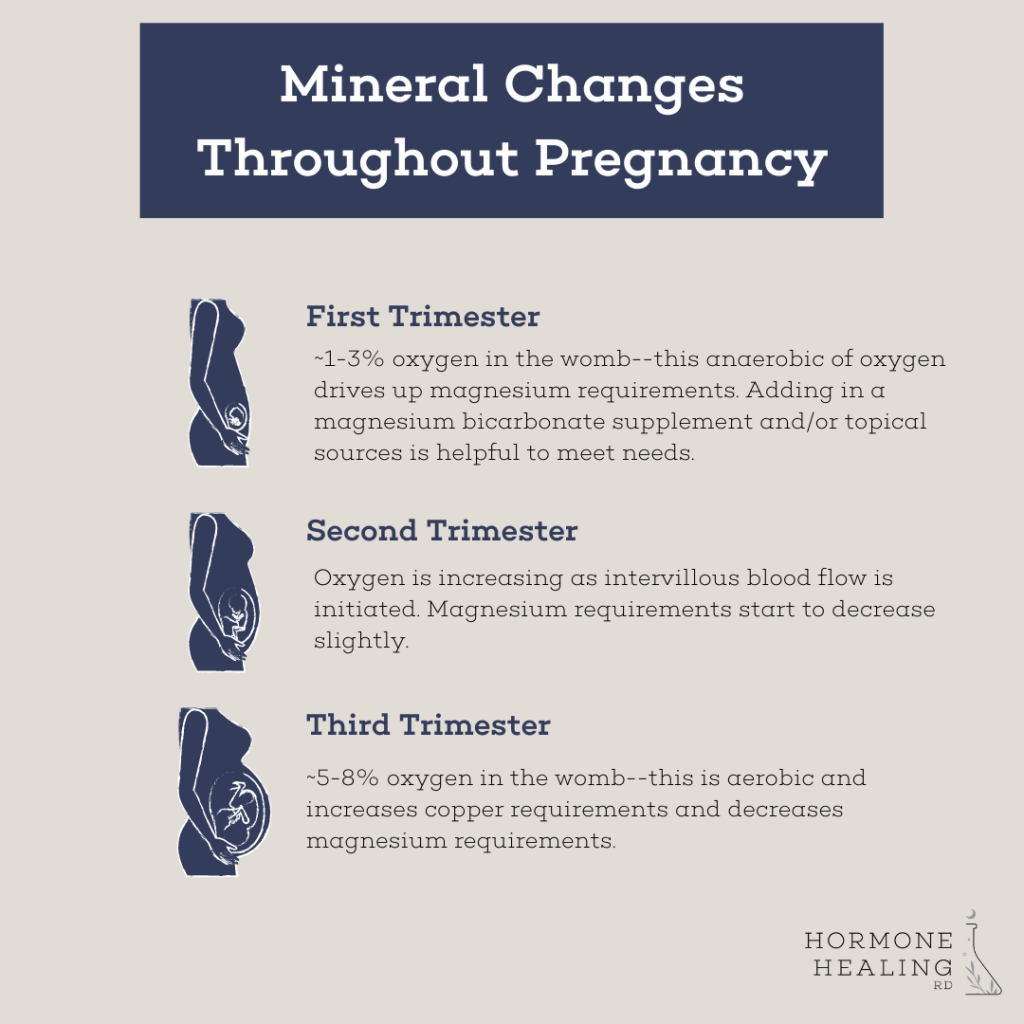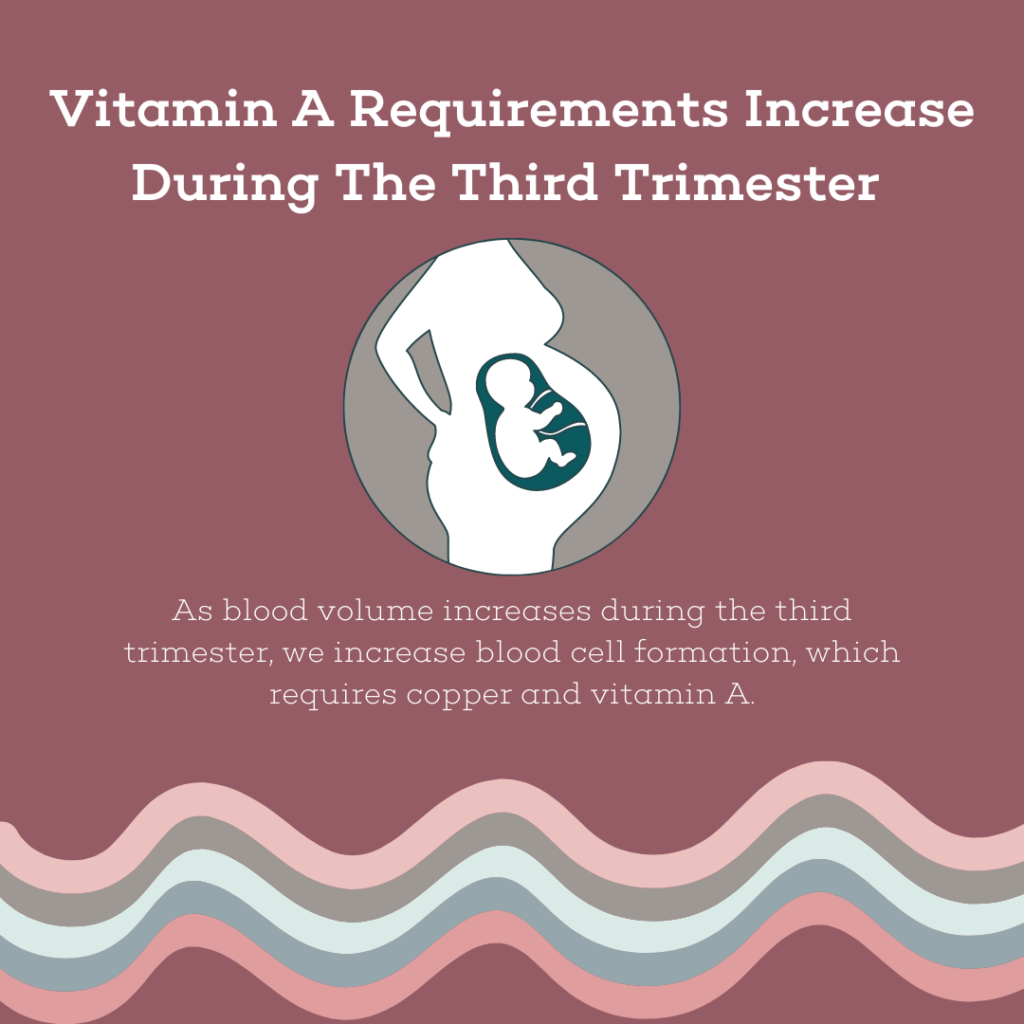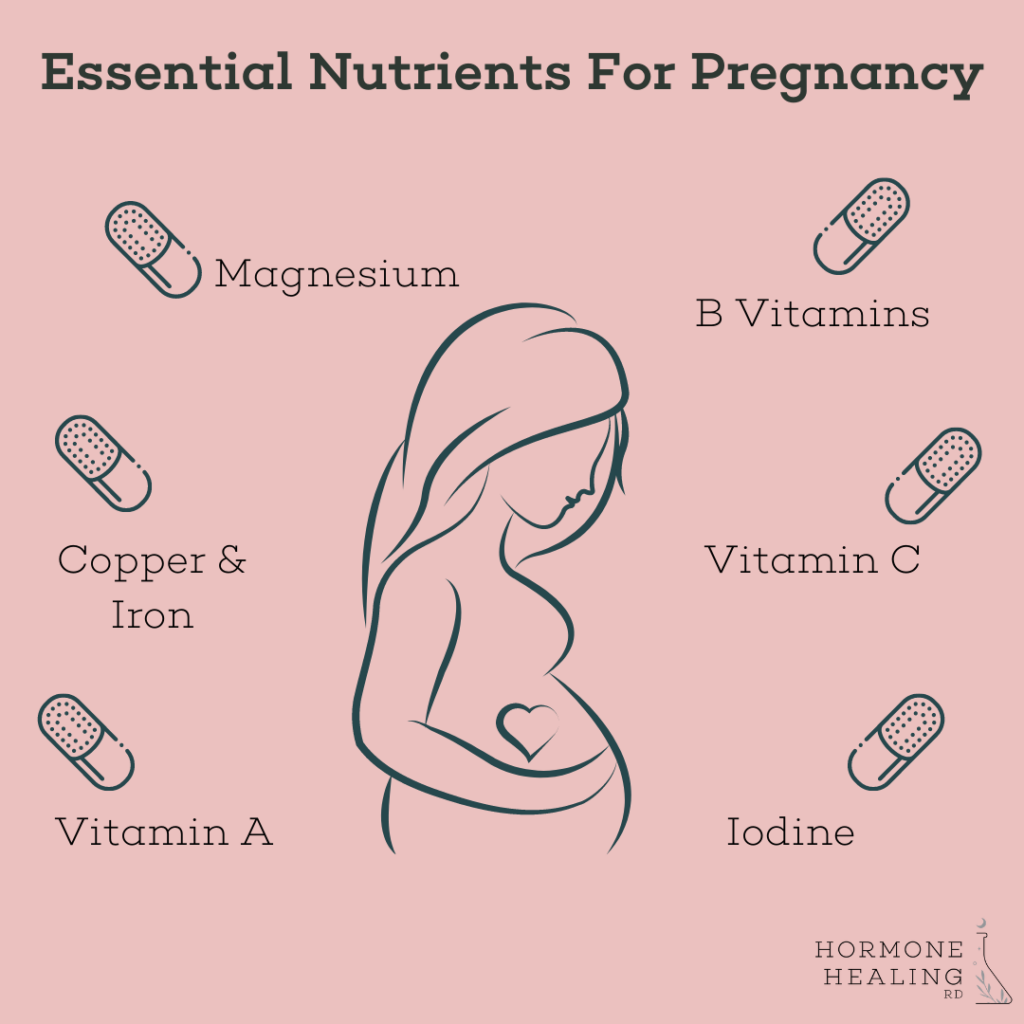There’s a lot of information out there regarding prenatal nutrition. Similar to information regarding hormone health, it’s all conflicting, which leads to confusion. I feel the same about both–women should be educated on how their bodies work and what their nutrient requirements are, and then make the best decision for themselves.
I think one of the best places to start when it comes to misunderstood nutrients during pregnancy is magnesium and copper. Our magnesium needs are higher in the first and second trimester than the third because of the amount of oxygen in utero. This shift from an anerobic (low oxygen) to aerobic (normal oxygen) state from the first to third trimesters, leads to a decrease in magnesium requirements and an increase in copper requirements. We use copper with oxygen to help the body make energy, so it makes sense that a higher oxygen state in the third trimester would mean we need more copper.

First Trimester:
This is when oxygen is low–creating a hypoxic or anaerobic state. This increases our magnesium requirements. Most prenatals only contain 100mg of magnesium, which is not enough for most women to meet their needs. There is quite a bit of research on magnesium supplementation during pregnancy and how it can improve health outcomes. You can know look at your magnesium levels by testing Magnesium RBC. Optimal is 6.5 mg/dl.
Second Trimester:
Oxygen is starting to increase around weeks 16-18 since intervillous blood flow is initiated in the womb. Magnesium requirements start to decrease. Many women experience heartburn during this time–magnesium bicarbonate can be helpful for this and supportive of magnesium requirements.
Third Trimester:
Oxygen increases to an aerobic state, which lowers magnesium requirements, but increases copper requirements. Our blood volume is also growing so much during this time, which requires more copper and vitamin A. If you’ve been told you’re anemic during this time because of a low hemoglobin level, I cannot stress the importance of understanding that hemoglobin levels are supposed to drop during the third trimester. 8.5-9.5 is optimal because of the increasing blood volume. A lower hemoglobin is actually a driver for a healthier birth, especially if copper levels are adequate. Learn more here.
In traditional cultures, vitamin A rich foods are prioritized for pregnant women to ensure that the mother and baby are healthy. This makes sense since vitamin A helps cells proliferate and ensure proper organ development during pregnancy.
I believe the Weston A. Price Foundation says it best when they emphasize the importance of vitamin A.
“After the formation of all the organ systems, vitamin A supports their growth. Chronic vitamin A deficiency during pregnancy compromises the liver, heart, and kidney and impairs lung growth and development during the last weeks of gestation.”
Unfortunately, pregnant women are advised to avoid vitamin A rich foods like beef liver and cod liver oil. This recommendation is given because of a study done that linked some birth defects to vitamin A supplementation. The key here is that they were correlated and that this was a recall study–they called the participants and had them do a survey. This typically has a very low accuracy rate. I also think it’s worth noting that the study was on vitamin A supplements and not foods that are high in vitamin A. Hopefully, you know by now that isolated nutrients don’t work the same as a whole food version of that nutrient. Beef liver, for example, has a lot of vitamin A, but it also has a significant serving of copper, which works with vitamin A in the body. While supplementing with an isolated version of vitamin A may be too much (even though many studies show this isn’t an issue), eating the real thing provides a lower dose of vitamin A with other essential nutrients.
Vitamin A Requirements & The Third Trimester
As usual, the nutrition information given to women has zero nuance. While I’m not sold that we need a ton of vitamin A during the first trimester, I am very convinced that during the second and third trimester, as blood volume and copper requirements increase, we do need more vitamin A. Including vitamin A rich foods like beef liver more often during the third trimester would be my ideal way of boosting those nutrients. I also think it’s important to test and not guess. Check your retinol (vitamin A) levels via a blood test. Ideally, they are 2.5-3x higher than your vitamin D 25 OH levels.

How To Get More Vitamin A
Vitamin A is a fat-soluble vitamin, which means we need to get it from foods with saturated fat, and we need fat to absorb it properly. It’s best to get vitamin A in animal food form. The main reason for this is because it gives us retinol. Retinol is very different from beta carotene, which is the type of vitamin A found in plants. Our bodies have to convert beta carotene into retinol in the body, which varies from 5-65% in humans. It’s also been shown that too much beta carotene can limit the conversion into vitamin A in the body. Here are the best forms of vitamin D:
It’s interesting because every pregnant client I have worked with, as well as loved ones, always crave some form of dairy when pregnant. Often if they didn’t tolerate dairy well before pregnancy, they feel fine eating it during pregnancy. It’s rich in vitamin A and calcium, which are both important for prenatal development. Our bodies are so smart!
Is folate important for fetal development? Absolutely, but just like anything else, we can get too much. Especially with the emphasis on folate during pregnancy and the abundance of fortified foods, plus the large amount of folate found in prenatal vitamins. Research now shows, that taking in folate and vitamin B12 in excess is associated with an increased risk of autism. This doesn’t mean that one causes the other, but I do think there is cause for concern with the high levels of nutrients found in prenatals. For example, one popular prenatal contains 5,357% of the RDA for vitamin B12 and 227% of the RDA for folate. My concern is that women are still eating food while taking a prenatal, so not only are those levels high, but the woman taking that prenatal is likely getting even more.
The other area of concern that comes up is that folate is a copper-dependent vitamin, this means we cannot get all of the benefits of folate without adequate copper in our diets. Many of the copper-rich foods I recommend (beef liver, bee pollen/royal jelly) are frowned upon during pregnancy, however, when we look at traditional cultures, these are the foods given to pregnant women to support a healthy mom and baby. Fun fact: beef liver also contains folate–3oz of beef liver has just over 200mcg of folate in the easily absorbable form. The more you look into the nutrients in beef liver, the more you will see a connection with a healthy pregnancy.
Choline is another important nutrient for pregnancy. It is responsible for liver and brain development along with many other tissues making it an essential nutrient for the development of the baby. Our bodies can actually substitute choline for folate if needed for certain reactions too, which is pretty cool. Choline is found in eggs, beef liver, dairy, and fish.

Prenatal Concerns & Comparison
I have gotten SO many questions on different prenatals, and I am often asked which one I think is best. Honestly, this is a difficult question. When working with clients, it’s much easier to answer because we have their labs and know what nutrients they need. Many prenatals contain nutrients that aren’t helpful (example: iron–can be inflammatory, women also are NOT bleeding during pregnancy, which reduces our iron requirement) and in forms that aren’t great for us (example: beta carotene–in exess is harmful and most of us are not converting this to adequate levels of retinol–vitamin A). A lot of what I am going to share may go against things you have learned. You don’t have to agree with me, but you likely want to learn more and do your research if you’re on this email list. All I ask is that you keep an open mind and do your research. You don’t have to listen to me. I share my two favorite resources for prenatal nutrition at the end of this section.
Problematic Ingredients In Prenatals
Prenatal Supplement Comparison
In the chart below, you will see six popular prenatal supplements and important nutrients highlighted. To make this as easy as possible, I used 3 main colors to show beneficial and non-beneficial ingredients/aspects of the supplements.

Build Your Own Prenatal
As you can see, I wouldn’t recommend any of these prenatals. What do I recommend instead? Building your own and using FOOD!
What About Folate?!
Here is an example of how to get the 600mcg recommendation:
What About DHA?!
You can consider a cod liver oil supplement like Rosita to provide adequate DHA. This will also provide vitamin D.
First Half of Pregnancy Considerations
The first half of pregnancy requires more magnesium. Consider supplementing with more or adding a topical source like those listed above.
Second Half of Pregnancy Considerations
The second half of pregnancy requires more copper and vitamin A. Consider eating more beef liver, shellfish, and fatty fish.
I want to end this with an important note:
I see a pattern happen with my clients when they get pregnant–they go from feeling confident in their nutrition and lifestyle choices to questioning everything as soon as women find out they are pregnant. Worry sets in, and instead of following their intuition, they take in a ton of outside information based on faulty research and, honestly, guesses.
It’s important to remember that our bodies are designed to carry life. While we want to be smart with nutrition and supplements that can cause harm during pregnancy, I think it’s essential to look at traditional cultures and their principles for pregnancy. Many of these include nutrient-dense foods like organ meats, cod liver oil, and a diet based on mostly whole foods. They also prioritize child spacing to make sure both the mother and baby remain healthy.
There’s so much more I can say on this topic, but I hope this inspires you to look beyond the mainstream health information out there for pregnancy and use sources like The Root Cause Protocol and Weston A. Price to build on your prenatal nutrition knowledge.
